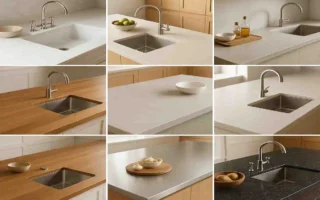Buying a home is becoming increasingly expensive. The International Monetary Fund reports that the cost of a home in the OECD’s mostly high-income countries has risen by 37% in real terms, and prices are up 16% relative to incomes. As housing prices continue to rise across cities and suburbs alike, more homeowners and renters are embracing smaller living spaces. Whether it’s a compact studio apartment, a downsized family home, or a purpose-built accessory dwelling unit (ADU), the need to make every square meter count has never been more important.
But small doesn’t have to mean cramped. Through smart design choices, a small room can feel spacious, bright, and inviting. One design element that makes a significant impact in small spaces is the window, particularly curved windows. These architectural features don’t just let in light—they open up rooms both visually and functionally, turning tight corners into charming focal points.
In this article, we’ll explore how curved windows can make small spaces feel bigger, offer tips for installation, and highlight the often-overlooked benefits of natural light.
Windows: The Illusion of Space
An article on Why Window Views Can Change Your Perspective details how windows have long been used to alter the perception of space. By bringing in daylight and offering views to the outdoors, they break the confinement of walls and visually expand the size of a room. In small homes, this effect is amplified—light becomes an essential design tool that makes the interior feel more breathable and less restricted.
Even a standard rectangular window helps reduce the feeling of enclosure. But when it comes to maximizing the visual space of a room, curved windows offer an elevated effect. They bend light and shape in a way that draws the eye outward and softens the room’s hard edges.
Why Curved Windows Work Better in Small Rooms
Curved windows—whether arched at the top, bow-shaped, or featuring a full radius—bring a sense of movement and elegance that rigid square windows can’t match. But their value isn’t just aesthetic; curved windows enhance spatial perception in the following key ways
Softened Edges and Organic Flow
Where sharp corners can make a space feel boxy, curved lines suggest continuity. This architectural softness changes the way we perceive the space—it feels less confined, more fluid, and more relaxing.
Added Depth and Projection
Bay and bow windows physically extend past the wall, providing not only extra interior shelf or seating space but also a broader angle of outdoor visibility. This trick of depth makes even a tight room feel like it has more dimension.
Visual Height and Drama
Arched windows naturally draw the eye upward, which is especially useful in rooms with low or flat ceilings. This gives the impression of greater height, even if the square footage stays the same.
Installing Curved Windows: What to Know
While curved windows offer stunning results, their installation requires thoughtful planning and professional expertise. Here’s what to keep in mind if you’re considering them for your home:
Assess the Structure
Not every wall is ideal for a curved window. Factors like load-bearing elements, plumbing, or electrical placement must be considered. A professional contractor or architect can assess the feasibility before work begins.
Choose the Right Style
There are multiple curved window styles suited to different functions:
- Arched windows are excellent above doors or as accent pieces in bedrooms or bathrooms.
- Bay windows add seating and natural light in kitchens or living rooms.
- Bow windows offer a panoramic view and increased light entry in tight spaces.
Material and Glass Options
Choose energy-efficient glass to reduce heat transfer—a must for small spaces where temperature control is harder. Frame materials like vinyl, aluminum, or treated wood can complement both modern and traditional interiors.
Hire a Professional Installer
Installing curved windows presents a unique set of challenges that go far beyond standard window replacement. The elegant arc of a curved window adds sophistication and character to a home, but achieving that look requires precision and expertise. Every aspect of the process—from the initial measurements to the final seal—must be executed with a high level of skill and attention to detail. Unlike traditional windows, the curvature must match exact specifications, or it could result in poor alignment, structural gaps, or even frame distortion. A miscalculation as small as a few millimeters can compromise the integrity and function of the entire unit.
A professional installer understands how to mitigate these risks. They use specialized tools and materials that are often unavailable to the average homeowner. More importantly, they bring years of experience and technical knowledge that allows them to anticipate and address problems before they arise. Flickinger Glassworks, which specializes in crafting and installing custom curved glass, details how working with experts ensures that every curve is cut and fitted to exact standards. Their familiarity with the materials and installation techniques helps create a seamless fit that not only looks beautiful but also performs flawlessly for years to come.
Lighting the Way: Natural Light in Small Rooms
Beyond aesthetics, curved windows greatly enhance natural light. Their shape allows more angles of sunlight to enter the room throughout the day, compared to flat windows which limit entry points based on the sun’s position.
Natural Light Expands Space
In interior design, light equals space. Brightness minimizes shadows and visually erases hard boundaries in a room, making even the smallest corners feel inviting.
Health and Mood Benefits
Exposure to natural light is scientifically proven to:
- Improve mood and reduce stress
- Support healthy sleep cycles
- Boost productivity
- Lower energy use during the day
This makes curved windows especially beneficial in home offices, bedrooms, and bathrooms where natural light is often lacking.
Energy Savings
With more daylight comes less need for artificial lighting and heating during cooler seasons. A post from gb&d Magazine outlines how well-placed windows can contribute to passive solar heating.
Design Tips to Maximize Curved Window Impact
Once you’ve added a curved window, you can amplify its effect with these design choices:
- Use Light Curtains or Leave Uncovered
Keep it minimal. Heavy drapes defeat the purpose by blocking light and space. Opt for sheer fabrics or motorized shades.
- Install Built-in Seating
Curved windows in bay or bow form create natural nooks. Adding a cushioned bench not only utilizes the space but also creates a cozy, functional retreat.
- Coordinate Interior Lines with the Window Curve
Arched mirrors, rounded furniture, or soft-edged décor can echo the window shape and create harmony in a small room.
- Keep the Surrounding Area Clear
Avoid cluttering the window space with bulky furniture. Let the light and shape take center stage.
Conclusion: Small Space, Big Transformation
When every square meter counts, design choices need to work smarter—not harder. Curved windows offer a powerful combination of beauty, functionality, and spatial enhancement that flat windows simply can’t match.
They create visual flow, extend depth, and bring in abundant natural light—all of which are crucial in smaller homes. While the installation may come at a higher initial cost, the long-term benefits—from added comfort to higher resale value—make curved windows a smart investment.
For homeowners looking to elevate their compact spaces, the curve is more than just an aesthetic—it’s a space-creating solution that transforms how you live. For more ideas on small spaces, check out our post on Home Space-Saving Ideas to Make Your Life More Efficient.
You may aslo read (choosing window treatment styles for a new home in the villages).




